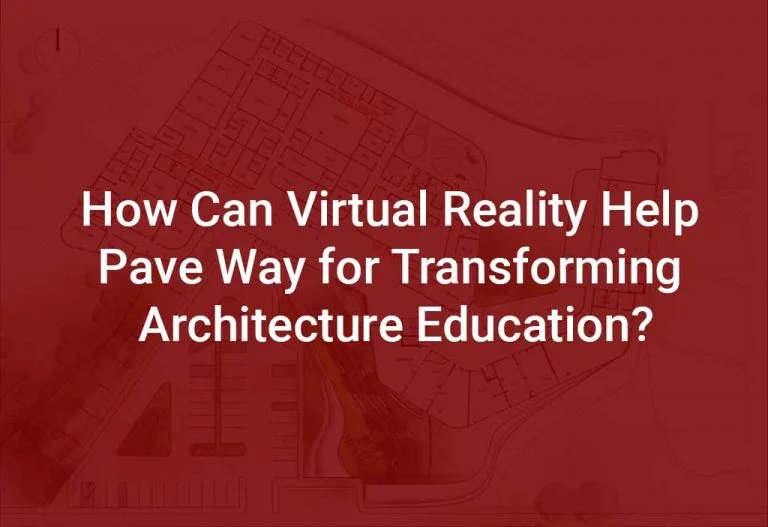
HOW CAN VIRTUAL REALITY HELP PAVE WAY FOR TRANSFORMING ARCHITECTURE EDUCATION?
Blending vision of structural creativity with adept techniques of construction is ideally the prime and exquisite knowledge, which academic curriculum of Architectural education aims at infusing into every young mind pursuing the same. Students of this distinguished study field possess the definite capacity of giving building engineering a holistic dose of art. Dressing up any and every edifice with vibes of wondrous aesthetics remains the oath of all B. Arch students. And all the known structures around the world like the Cologne Cathedral of Germany and modern-day Petronas Tower duo of Kuala Lumpur stand as the finest representations of this virtuous resolution. To say a little more, the 99 diversely shaped concrete panels of Prague’s Dancing House or those striking 8 slender isosceles triangles of New York’s 1776 feet long One World Trade Center further prove prowess of architects in mixing artistry with strategies of engineering.
Such esteemed edifices and their distinctive patterning undoubtedly amplify exclusiveness of Architecture as an educational branch to pursue for.
But, given to the 22nd century’s changed concept of living life and conducting work and in relation augmenting demand for perfection, luxury, class, and easiness, the pedagogy of structural design stands at a conjecture of evolution. The every-day increasing requisite to acquire all sorts of facilities within the set-up of office and home and the growing cosmopolitan desire for having more of travel-pacing flyovers and place-connecting bridges message architectural academics indispensable need for its development through re-shuffling of teaching strategies and learning processes. This is where the ever-progressive world of Virtual Reality (VR) stands as a chief agent for this much-required refurbishment.
In order to accomplish the standard of accuracy desired nowadays, students, at the foremost, need to get involved with the recurring cycle of ‘Iterative Design’ and bring out the best of structural blueprints through collaborative experiments, shared analysis, and agreed-by-all refinement. To speed-up such an endeavor and ensure impeccability of end-result, worthiness of VR emerges as a cardinal one. By the help of this certain technology, students become enabled to create simulating visual building sites and find it more easy to discuss among selves about the aspects of enhancement in their prospective project, while virtually being there. This, in effect, holds power to revolutionize the task of prototyping structure schemes. Since an architect gets to ‘travel’ through his/her dream infrastructure, marking that with symbols of exquisiteness becomes an uncomplicated and more enthusiastic assignment to execute.
Besides, VR also aids teachers to explain fundamentals of the pedagogy and inherent techniques of construction in a more effective and ‘smartened up’ maneuver. By aptly utilizing this tool, 3D sketches, line drawings, and scale paradigms can be prepared, which upon trying have been vowed by scholars across the world to be authentically handy over the 2D CAD diagrams for imparting architectural education. Teachers often claim that students find it little difficult to decipher the exactitude, 2D drawings, and plan-sheets or propose own views through them. According to the maestros, all those tasks for learners become more complacent when they get access to the opportunity of 3D drafting.
The agility offered by Three-Dimensional methodology, in specific, assists educators to enlighten students about the nerve points of architecture. How to be ascertained of exact numbers of levers in a state-of-the-art bridge, if or not elevation is at the right measure, or what is the actual way of drainage construction at a ‘Designer Home’— answers to all such questions are delivered much easily to the learners through 3D illustrations. Since all the paradigms are getting viewed, students find it crystal-clear to interpret and feel motivated to provide ingenious inputs.
Wisdom about choice and right usage of constructional material in relation to the building’s purpose and surrounding environment too turns trouble-free for both the teacher to impart and students to digest. Moving 3D depictions about the pros, cons, and sustainability of certain structural elements in regard to the background factors are logically more potential to get merged into an architectural student’s thought-process than plain sketches. In contemporary times, educational institutions are also gradually getting engaged in the attempt to transform 2D models and drawings of famous yesteryear buildings into deft 3D projections for students to understand their pedagogy’s legacy in an authentically useful manner.
The cardinal contribution of VR technology in taking Architecture study to a ‘Level Up’ is imbibed in the advantage of floor plan’s 360-degree detailed view and in-depth analysis of signature spaces. With aid of Third Dimension based patterns, the fresh brains of this talked-about academics, accomplish with aptness, perfect ways to shape-up practical yet artistic flooring set-ups. Availability of a Head Mounted Display further enables the architects to decode those so-vital tactics to build designer spaces and offer that much coveted ‘Architectural Spatial Experience’ to consumers.
Virtual Reality also enacts as a true progressive catalyst in the process through which learners are endowed with site tours. With regard to the amplitude and distantness of structural wonders spread throughout the globe, within those 3-5 years of study, it appears as an impossible job to conduct an expedition to even the most recognized spots so as to understand what architectural wonders they are. But if approached by the ‘Virtual’ path, then that hard-to-achieve task transforms into a wholesomely accomplished experience. Simulating Panoramic views of the inside construction of heritage edifices and stunning modern-day towers and layer after layer beholding of their innate infrastructural arrangements can implicitly stimulate study and push each student to the finishing line of impeccability. Another very dynamic merit of VR is the perk of VR-EP (Empathy Platform), the inclusion of which into the curriculum, enables students to understand how to customize constructions for people with disabilities and groom house staffs for special conditions. The unique digital device also dwells as an important factor while planning townships in SEZ areas.
This discussed-about evolvement of structural design education has been quite promisingly adopted by us, at the K.R Mangalam University. The University’s School of Architecture caters a most distinguished course model that makes sure that each and every architectural student of ours possesses deep-seated knowledge over academic’s fundamentals and is equipped to meet any upcoming change and challenge in the building profession. Learners are bestowed with such a holistic education that combines academic excellence with thorough in-hand work training. Students at KRMU are encouraged to think not only about shaping up one particular majestic building but for enriching the totality of the human living framework.
Constant emphasis is rendered to the aspect of ecological structures and issue of long-persisting build-ups. By regularly organized interactions with esteemed academic personas, field experts and professionals, students gain conversancy about procedures to put their visions into missions. We, at the K.R Mangalam University, always see to it that our students are versed with the latest of technologies that pave way for enriching and perfecting learning of spatial ideas and their different possible metamorphoses and beautification can be geared to an unthinkable dimension.
Recent Post
